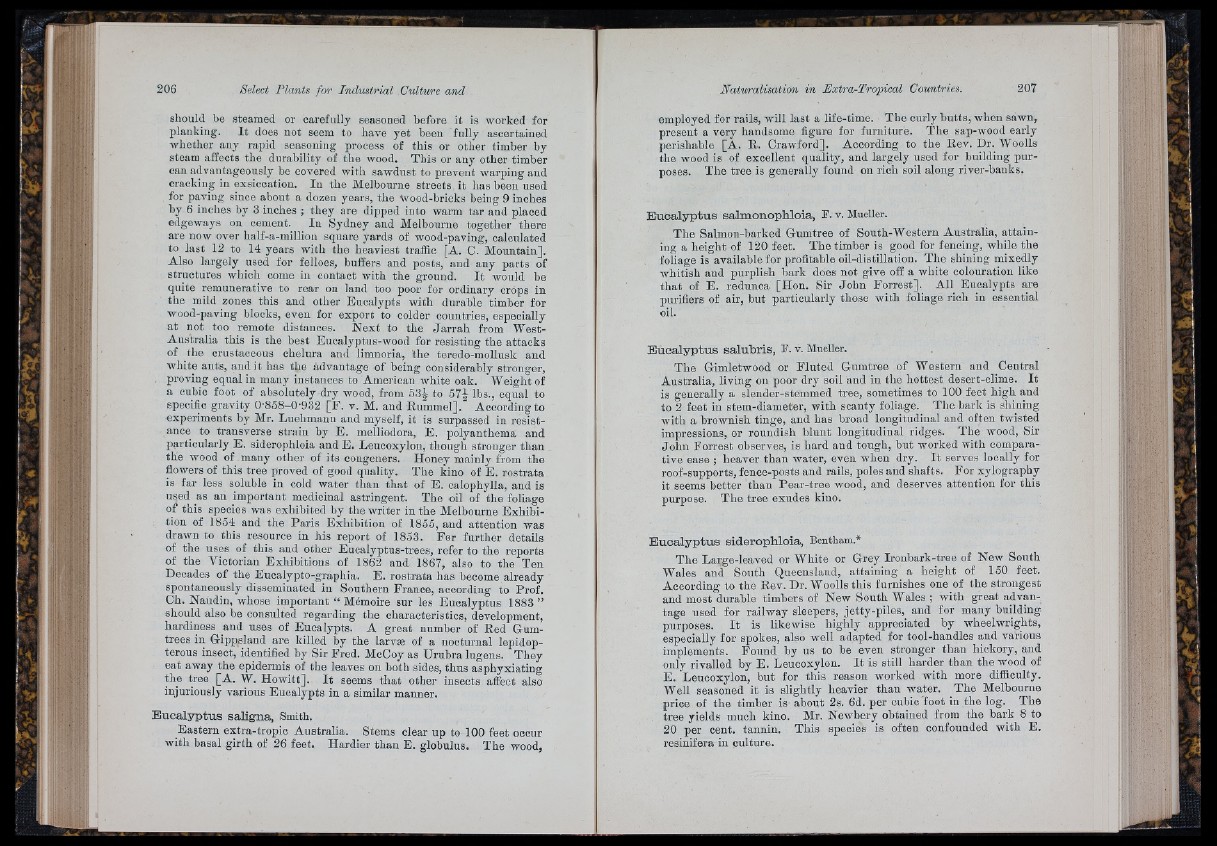
should be steamed or carefully seasoned before it is worked for
planking. I t does not seem to have yet been fully ascertained
whether any rapid seasoning process of this or other timber by
steam affects the durability of the wood. This or any other timber
can advantageously be covered with sawdust to prevent warping and
cracking in exsiccation. In the Melbourne streets it lias been used
for paving since about a dozen years, the wood-bricks being 9 inches
by 6 inches by 3 inches ; they are dipped into warm tar and placed
edgeways on cement. In Sydney and Melbourne together there
are now over half-a-millioii square yards of wood-paving, calculated
to last 12 to 14 years with the heaviest traffic [A. C. Mountain].
Also largely used for felloes, buffers and posts, and any parts of
structures which come in contact with the ground. I t would be
quite remunerative to rear on land too poor for ordinary crops iu
the mild zones this and other Eucalypts with durable timber for
wood-paving blocks, even for export to colder countries, especially
a t not too remote distances. N ex t to the Ja rra h from West-
Australia this is the best Eucalyptus-wood for resisting the attacks
of the crustaceous chelura and limnoria, the teredo-mollusk and
white ants, and it has the advantage of being considerably stronger,
proving equal in many instances to American white oak. Weight of
a cubic foot of absolutely dry wood, from 531 to 57^ lbs., equal to
specific gravity 0-858-0-932 [F . v. M. and Rummel]. According to
experiments by Mr. Luehmann and myself, it is surpassed in resistance
to transverse strain by E . melliodora, E . polyanthema and
particularly E. siderophloia and E. Leucoxylon, though stronger than
the wood of many other of its congeners. Honey mainly from the
flowers of this tree proved of good quality. The kino of E. rostrata
is far less soluble in cold water than th a t of E. calophylla, and is
used as an important medicinal astringent. The oil of the foliage
of this species was exhibited by the writer in the Melbourne Exhibition
of 1854 and the Paris Exhibition of 1855, and attention was
drawn to this resource in his report of 1853. For further details
of the uses of this and other Euoalyptus-trees, refer to the reports
of the Victorian Exhibitions of 1862 and 1867, also to the Ten
Decades of the Eucalypto-graphia. E. rostrata has become already
spontaneously disseminated iu Southern France, according to Prof.
Ch. Naudin, whose important “ Mémoire sur les Eucalyptus 1883 ”
should also be consulted regarding the characteristics, development,
hardiness and uses of Eucalypts. A great number of Red Gum-
trees in Gippsland are killed by the larvæ of a nocturnal lepidop-
terous insect, identified by Sir Fred. McCoy as Umbra lugens. They
eat away the epidermis of the leaves on both sides, thus asphyxiating
the tree [A. W. Howitt]. I t seems th a t other insects affect also
injuriously various Eucalypts in a similar manner.
E u c a ly p t u s s a lig n a , Smith.
Eastern extra-tropic Australia. Stems clear up to 100 feet occur
with basal girth of 26 feet. Hardier than E. globulus. The wood,
employed for rails, will last a life-time. The curly butts, when sawn,
present a very handsome figure for furniture. The sap-wood early
perishable [A. R. Crawford]. According to the Rev. Dr. Woolls
the wood is of excellent quality, and largely used for building pur-
The tree is generally found on rich soil along river-banks.
Eucalyptus salmonophloia, F. v. Mueller.
The Salmon-barked Gumtree of South-Western Australia, a tta in ing
a height of 120 feet. The timber is good for fencing, while the
foliage is available for profitable oil-distillation. The shining mixedly
whitish and purplish bark does not give off a white colouration like
th a t of E. redunca [Hon. Sir John Forrest]. All Eucalypts are
purifiers of air, but particularly those with foliage rich in essential
oil.
Eucalyptus salubris, F. v. Mueller.
The Gimletwood or Fluted Gumtree of Western and Central
Australia, living on poor dry soil and in the hottest desert-clime. I t
is generally a slender-stemmed tree, sometimes to 100 feet high and
to 2 feet in stem-diameter, with scanty foliage. The bark is shining
with a brownish tinge, and has broad longitudinal aud often twisted
impressions, or roundish blunt longitudinal ridges. The wood, Sir
Jo h n Forrest observes, is hard and tough, but worked with comparative
ease ; heaver than water, even when dry. I t serves locally for
roof-supports, fence-posts and rails, poles and shafts. F or xylography
it seems better than Pear-tree wood, and deserves attention for this
purpose. The tree exudes kino.
Eucalyptus siderophloia, Bentham.*
The Large-leaved or White or Grey Ironbark-tree of New South
Wales and South Queensland, attaining a height of 150 feet.
According to the Eev. Dr. Woolls this furnishes one of the strongest
and most durable timbers of New South Wales ; with great advantage
used for railway sleepers, jetty-piles, and for many building
purposes. I t is likewise highly appreciated by wheelwrights,
especially for spokes, also well adapted for tool-handles and various
implements. Found by us to he even stronger than hickory, and
only rivalled by E . Leucoxylon. I t is still harder than the wood of
E . Leucoxylon, but for this reason worked with more difficulty.
Well seasoned it is slightly heavier than water. The Melbourne
price of the timber is about 2s. 6d. per cubic foot in the log. The
tree yields much kino. Mr. Newbery obtained from the bark 8 to
20 per cent, tannin. This species is often confounded with E.
resinifera in culture.